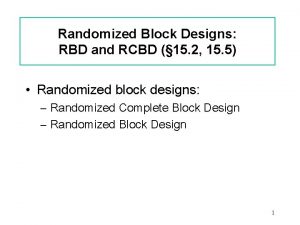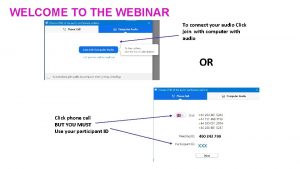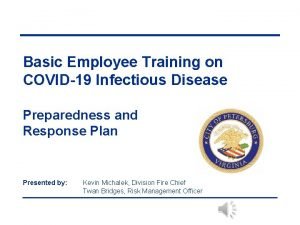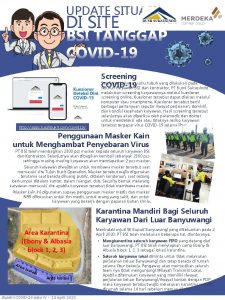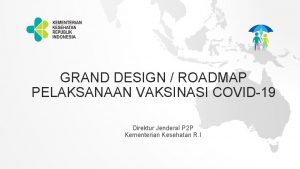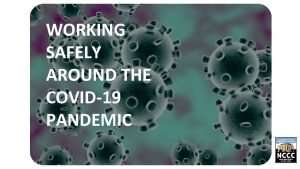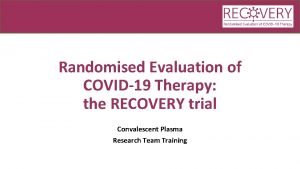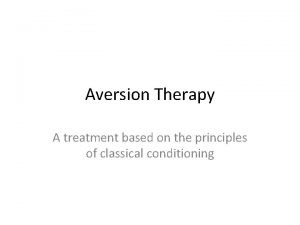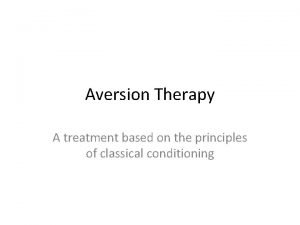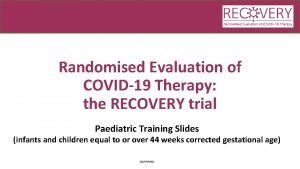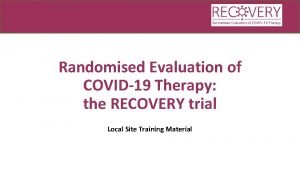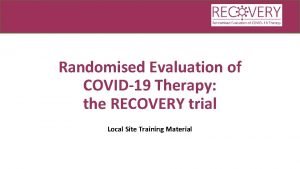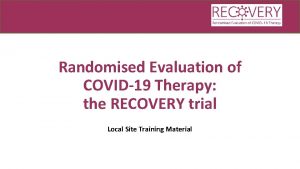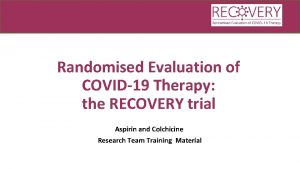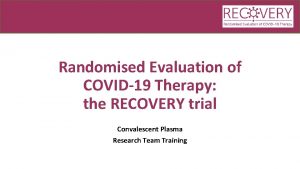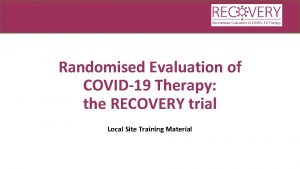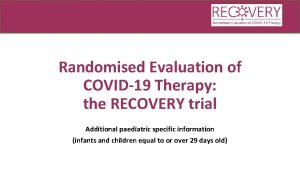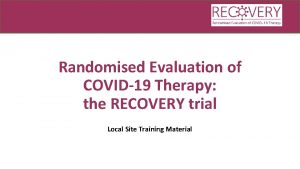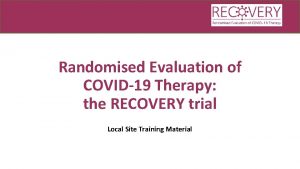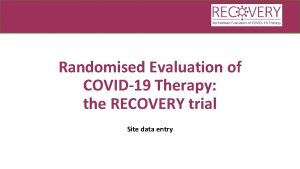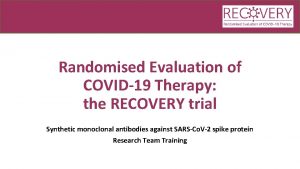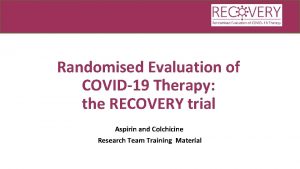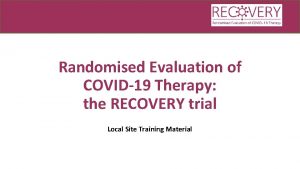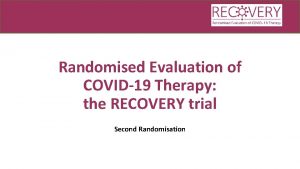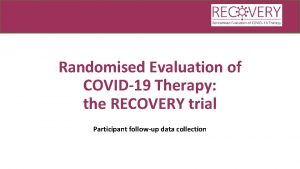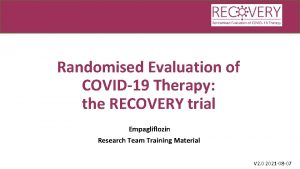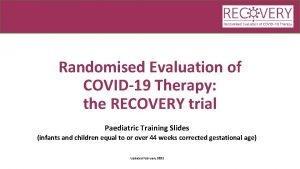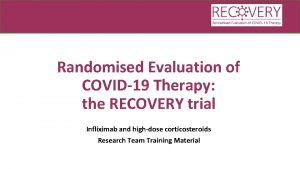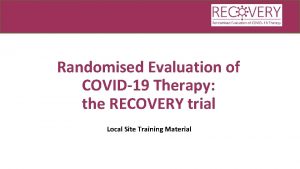Randomised Evaluation of COVID19 Therapy the RECOVERY trial
























- Slides: 24

Randomised Evaluation of COVID-19 Therapy: the RECOVERY trial Local Site Training Material

Background • A novel coronavirus-induced disease was identified in Wuhan, China (COVID-19) • In January 2020 the Chinese CDC identified the causal agent as a new betacoronavirus (SARS coronavirus 2 or SARS-Co. V-2) • Symptoms vary from none to severe pneumonia in a minority • It is estimated that in the UK 50 million people may be infected, of whom 5% may need admission and of these 30% might need level 3 (ICU) care • The progression from prodrome to severe disease takes 1 -2 weeks, offering a therapeutic window • Currently there are no proven therapies for COVID-19

RECOVERY trial design No additional treatment ELIGIBLE PATIENTS Lopinavir-ritonavir 400/100 mg bd PO for 10 days 1. Age ≥ 18 years 2. Admitted to hospital 3. Proven or suspected SARSCo. V-2 infection R Dexamethasone 6 mg od PO/IV for 10 days Hydroxychloroquine See protocol for dosing Azithromycin 500 mg od PO/IV for 10 days OUTCOMES Primary: all-cause death Secondary: • Duration of hospitalisation • Need for ventilation • Need for renal replacement therapy

Study treatments: Lopinavir-Ritonavir • Licensed for treatment of HIV • Lopinavir is a protease inhibitor (combined with ritonavir to increase lopinavir’s plasma half-life) • Shown to have in vitro activity against SARS and MERS viruses • Contraindications: severe hepatic insufficiency; co-administration with other drugs dependent on CYP 3 A metabolism (Alfuzosin, ranolazine, amiodarone, dronaderone, fusidic acid, neratinib, venetoclax, colchicine, astemizole, terfenadine, lurasidone, pimozide, quetiapine, dihydroergotamine, ergonovine, ergotamine, methylergonovine, cisapride, elbasvir/grazoprevir, ombitasvir/paritaprevir/ritonavir, lovastatin, simvastatin, lomitapide, avanafil, sildenafil, vardenafil, midazolam, triazolam. ) • Side-effects: diarrhoea, nausea and vomiting

Study treatments: Dexamethasone • Modulates immune system which may be beneficial in context of severe pneumonia with superimposed ARDS • Contraindications: none • Side-effects: hyperglycaemia, mood/sleep disturbance, hypernatraemia

Study treatments: Hydroxychloroquine • Anti-malarial drug which has in vitro activity against SARS viruses • Contraindications: long QT syndrome. • Macrolide antibiotics and quinolones should be prescribed with care as they also prolong the QT interval • Side-effects: QT interval prolongation (but arrhythmias rare), itchy skin (especially in dark-skinned patients), headache

Study treatments: Azithromycin • Commonly used antibiotic (“macrolide”) with antiviral and immunomodulatory properties • Contraindications: long QT syndrome, allergy to macrolide antibiotics • Side-effects: QT interval prolongation, interaction with other drugs (ciclosporin, digoxin)

Randomisation • If a study treatment is contraindicated in a given patient, then they can still be randomised • Randomisation will allocate them to one of the other treatments • Randomisation is ‘simple’ (i. e. no stratification or minimisation) • Randomisation ratio is 2 (standard care): 1: 1: 1

Identification and invitation • All adult patients with proven or suspected SARS-Co. V-2 infection admitted should be considered for trial • Should be discussed with senior member of clinical team and assuming 1. All eligibility criteria are met; and 2. No medical history that might, in the opinion of the attending clinician, put the patient at significant risk if he/she were to participate in the trial, the patient should be offered participation • All documents available on trial website: www. recoverytrial. net

Informed consent • Patient should be provided with Participant Information Sheet (2 pages) and allowed to read and ask any questions

Informed consent • Key points: • Ensure the patient has had time to ask any questions (they will be scared). • Participation is voluntary and they must understand that (and that if they do not enter the trial they still receive the best care currently available). • All treatments have side-effects and they will be monitored for these. • Some of their data will be shared with the trial team outside the hospital (and possibly government officials who might check the trial is being done properly). Anyone who sees their data is bound by strict confidentiality rules. • Their data will be stored on a computer for several years, but will be kept secure. The trial may collect data held about them from other sources (eg, routinely collected data in the NHS) for up to 10 years. • These are all listed on the consent form itself, so use this as your guide.

• If they are willing then they should write their name, sign and date consent page • Person receiving consent should do the same and write the hospital and patient name at the top • Make copies (or scan): • 1 for participant • 1 for site file (e-mail to local PI) • 1 for medical notes (or scan into EHR) med consent

Informed consent • If participant can give consent but is unable to sign then a witness may complete form on top of page 2 • Person receiving consent should complete their section • Make copies (or scan): • 1 for participant • 1 for site file (e-mail to local PI) • 1 for medical notes (or scan into EHR)

Informed consent • Some patients will be too ill to give informed consent • In this situation, provide Participant Information Sheet to legal representative (e. g. close relative, friend or doctor not involved in trial) • They complete form on bottom of page 2 • Person receiving consent should complete their section • Make copies (or scan): • 1 for participant • 1 for site file (e-mail to local PI) • 1 for medical notes (or scan into EHR)

Randomisation • Randomisation does not have to be done by the person who took consent • Randomisation must be done online and can be accessed via the trial website: www. recoverytrial. net • Follow links for “Randomisation” • You will be able to download a Participant Information Sheet/Consent Form here too in case you need it

Randomisation • Select your site from the second dropdown list and enter the username and password for your hospital in the password box • Click “Login”

Randomisation • Click on “Enrol patient into study”

Randomisation • Complete the fields shown • Scroll down the page

Randomisation • Complete the fields shown • Scroll down the page

Randomisation • Complete the fields shown • Questions A 15. 1 -3 refer to availability in your hospital (it may be your pharmacy does not have them all) • Please enter your name and an e-mail address at which you can be contacted in case of questions • Then press ‘Continue’

Randomisation • Review the data you have entered. • If you need to correct anything, click ‘Amend’ • If you wish to abandon, click ‘Cancel’ • Otherwise, click ‘Randomise’

Randomisation • Make a note of the allocation and ensure that it is prescribed on the participant’s drug chart • Record the study number in the medical record and on the consent form if available

Problems If you have any questions about the process or run into problems with the website please do one of the following: • Review our Frequently Asked Questions on the study website www. recoverytrial. net • E-mail the study team at recoverytrial@ndph. ox. ac. uk • Telephone the study team (24/7) on 0800 1385451 (urgent calls only please)

Problems If you have any questions about the process or run into problems with the website please do one of the following: • Review our Frequently Asked Questions on the study website www. recoverytrial. net • E-mail the study team at recoverytrial@ndph. ox. ac. uk • Telephone the study team (24/7) on 0800 1385451 (urgent calls only please)
 Rcbd design example
Rcbd design example Random block design
Random block design Covid19 athome rapid what know
Covid19 athome rapid what know What do if test positive covid19
What do if test positive covid19 Http//apps.tujuhbukit.com/covid19
Http//apps.tujuhbukit.com/covid19 Vaksin covid19
Vaksin covid19 Do if you covid19
Do if you covid19 Recovery trial training
Recovery trial training Pre trial therapy training
Pre trial therapy training What are the major humanistic therapies
What are the major humanistic therapies Psychoanalytic vs humanistic
Psychoanalytic vs humanistic Bioness bits cost
Bioness bits cost Lewisville speech therapy evaluation
Lewisville speech therapy evaluation Aversion therapy alcohol
Aversion therapy alcohol Aversion therapy evaluation
Aversion therapy evaluation Voi kéo gỗ như thế nào
Voi kéo gỗ như thế nào Thiếu nhi thế giới liên hoan
Thiếu nhi thế giới liên hoan Phối cảnh
Phối cảnh Một số thể thơ truyền thống
Một số thể thơ truyền thống Thế nào là hệ số cao nhất
Thế nào là hệ số cao nhất Slidetodoc
Slidetodoc Hệ hô hấp
Hệ hô hấp Số nguyên tố là số gì
Số nguyên tố là số gì Tư thế ngồi viết
Tư thế ngồi viết đặc điểm cơ thể của người tối cổ
đặc điểm cơ thể của người tối cổ
